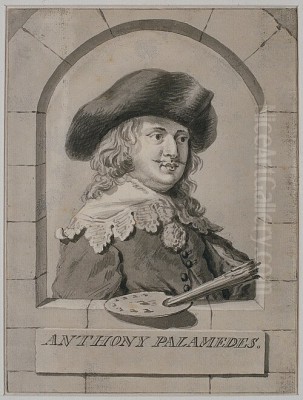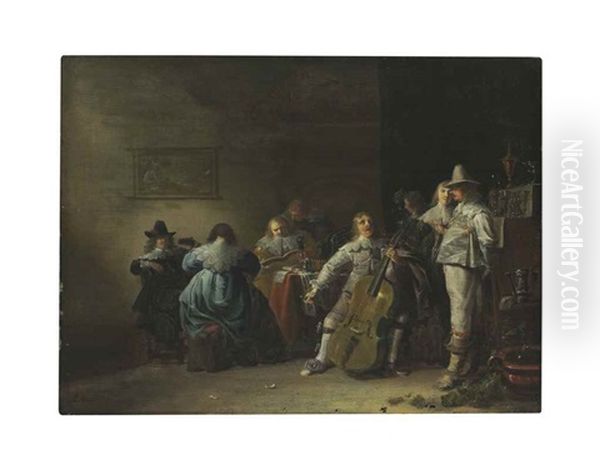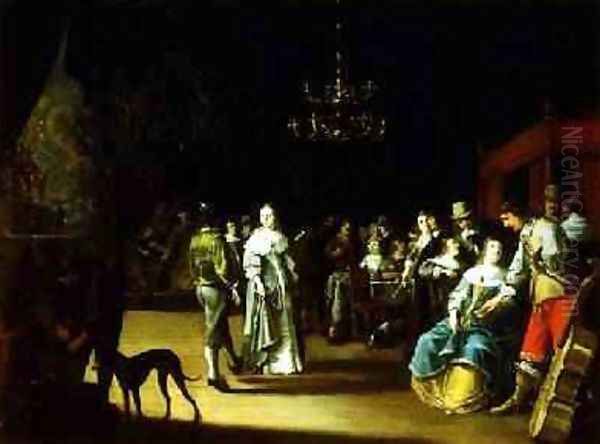
Anthonie Palamedesz, a notable painter of the Dutch Golden Age, carved a distinct niche for himself through his detailed and engaging depictions of 17th-century Dutch social life. Born in Delft in 1601 and passing away in Amsterdam in 1673, his life spanned a period of extraordinary artistic flourishing in the Netherlands. Palamedesz specialized in genre painting, particularly scenes of elegant companies engaged in music, conversation, and other leisurely pursuits, offering valuable visual insights into the customs and aesthetics of his time.
Early Life and Artistic Formation in Delft
Anthonie Palamedesz hailed from an artistic family. His father, also named Palamedes, was reportedly a sculptor and stone or gem cutter, possibly of Flemish origin, who had spent time in England working for King James I of Scotland and VI of England before settling in Delft. This artistic environment likely nurtured the talents of Anthonie and his younger brother, Palamedes Palamedesz. (1607–1638), who would become known for his battle scenes.
Delft, during the early 17th century, was a vibrant center for the arts and sciences. While specific details about Anthonie's earliest training remain somewhat unclear, it is documented that he may have studied under the prominent portrait painter Michiel Jansz. van Mierevelt and possibly Hans Jordaens. Some sources also suggest a potential apprenticeship or influence from the great Haarlem master Frans Hals, particularly given Palamedesz's skill in portraiture, though his primary focus would diverge towards genre scenes.
His brother Palamedes specialized in depicting cavalry skirmishes and military encampments, a genre quite different from Anthonie's focus on refined interior gatherings. Despite their differing specializations, the brothers represented the diverse artistic output emerging from Delft during this period. Palamedes the younger tragically died relatively young in 1638, while Anthonie enjoyed a long and productive career.
The Guild of Saint Luke and Professional Career
Crucial to any artist's career in the Dutch Republic was membership in the local Guild of Saint Luke. Anthonie Palamedesz joined the Delft guild in 1621, a step that formally recognized his status as an independent master painter. Membership provided artists with the right to sell their work, take on apprentices, and participate in the city's official artistic life. It also offered a degree of social and economic security.

Palamedesz remained an active member of the Delft guild for many years, even serving as its headman or 'hoofdman' multiple times, notably in 1635, 1658, 1663, and 1672. This indicates his respected position within the local artistic community. While primarily associated with Delft for most of his career, his presence was also felt in the larger artistic hub of Amsterdam, where he eventually moved and spent his final years, dying there in 1673.
His professional life centered on producing works for the burgeoning Dutch art market. The prosperity of the Dutch Republic created a wealthy merchant class eager to decorate their homes with paintings reflecting their lives and values. Palamedesz's elegant scenes of social gatherings perfectly catered to this demand.
Artistic Style: Capturing Merry Companies
Anthonie Palamedesz is best known for his "geselschapjes," or "merry company" paintings. These works depict groups of well-dressed men and women, often soldiers and civilians, enjoying themselves indoors. Common activities include playing music, card games, dining, drinking, flirting, and conversing. His style belongs firmly within the Dutch Golden Age tradition of realism, characterized by careful attention to detail, texture, and the accurate rendering of contemporary life.
His compositions are often complex, featuring multiple figures interacting within carefully arranged interior spaces. He paid close attention to fabrics, rendering the sheen of silk, the texture of velvet, and the intricate details of lace collars and cuffs with considerable skill. The settings often include fashionable furniture, musical instruments, paintings on the walls, and other objects that signify the comfortable lifestyle of the Dutch upper-middle class.
Compared to some contemporaries, Palamedesz's lighting is often even and clear, illuminating the scene without the dramatic chiaroscuro favoured by artists like Rembrandt van Rijn. The mood in his paintings is generally convivial and refined, sometimes with a subtle moral undertone related to moderation or the transience of pleasure, but primarily focused on depicting polite society at leisure. His figures, while sometimes appearing slightly stiff, are expressive enough to convey the social dynamics of the gathering.
Representative Works
Several key works exemplify Palamedesz's style and thematic concerns. "An Interior with Elegant Company" (specific versions exist in various collections) typically showcases his strengths: a group of figures in fashionable attire gathered in a well-appointed room. Often, music-making is central, with individuals playing lutes, violas da gamba, or singing, highlighting the importance of music in 17th-century Dutch social life. The interactions between the figures – glances, gestures, postures – create a narrative of polite sociability.

Another characteristic work is "Merry Company Dining and Making Music". Paintings with this theme depict groups enjoying food, wine, and musical entertainment. Palamedesz excels in arranging these multi-figure compositions, balancing the various elements and creating a sense of lively yet orderly activity. The detailed rendering of the tablecloth, food items, glassware, and musical instruments adds to the realism and richness of the scene.
While best known for genre scenes, Palamedesz was also a capable portraitist. His "Portrait of a Dutch Gentleman" (1657), for example, demonstrates his ability to capture a likeness and convey the sitter's status through clothing and bearing, aligning with the broader tradition of Dutch portraiture exemplified by artists like Frans Hals and Michiel Jansz. van Mierevelt. However, his most significant contribution remains his detailed chronicling of social gatherings. He also occasionally painted guardroom scenes (kortegaardjes), depicting soldiers at ease, a subgenre popular in the period.
Contemporaries, Collaboration, and Competition
The Dutch Golden Age was populated by a wealth of talented painters, creating an environment of both collaboration and intense competition. Palamedesz worked alongside and interacted with many prominent artists. His potential teachers, Michiel Jansz. van Mierevelt and Hans Jordaens I, were established figures in Delft. His brother, Palamedes Palamedesz., specialized in a different genre but was part of the same artistic milieu.
He is known to have collaborated with other artists. For instance, records suggest he worked with Ludolf de Jongh, a Rotterdam-born painter also active in Delft, possibly on architectural elements or backgrounds in paintings, including depictions of church interiors like the Oude Kerk or Nieuwe Kerk in Delft, or the St. Laurenskerk in Rotterdam. Such collaborations were not uncommon, allowing artists to leverage each other's specializations.
Palamedesz's chosen genre placed him in a field populated by other masters. In Delft itself, Johannes Vermeer was creating his serene and light-filled domestic interiors, though with a different focus and sensibility. Pieter de Hooch, also active in Delft for a time, excelled in depicting tranquil courtyards and domestic scenes with complex spatial arrangements.

Looking beyond Delft, artists like Willem Buytewech (in the earlier part of the century), Dirck Hals (brother of Frans Hals), Pieter Codde, and Willem Duyster in Amsterdam and Haarlem were also known for merry company and guardroom scenes. Later genre painters like Gerard ter Borch, Gabriel Metsu, Jan Steen, and Jacob Ochtervelt further developed the depiction of Dutch interior life, each with their unique style – Ter Borch known for his exquisite rendering of satin, Metsu for elegant narratives, Steen for lively and often humorous scenes, and Ochtervelt for entrance hall settings.
Within this competitive landscape, Palamedesz carved out his specific niche, focusing on slightly more formal and elegant gatherings than the boisterous scenes sometimes depicted by Steen, and with less psychological depth than Rembrandt or intimate focus than Vermeer. His works found a ready market, evidenced by their presence in contemporary inventories and their continued appearance in collections and auctions. The reported sale of one of his musical party scenes for £22,000 in a modern auction attests to his enduring appeal and market value.
Later Life and Legacy
Anthonie Palamedesz continued to paint throughout his life. His move to Amsterdam later in his career placed him in the largest artistic center of the Dutch Republic, though Delft remained the city most strongly associated with his artistic identity. He passed away in Amsterdam in March 1673 and was buried there.
His legacy lies in his contribution to Dutch genre painting. Through his numerous depictions of social gatherings, Palamedesz provides a detailed visual record of the leisure activities, fashion, and social customs of the Dutch elite and upper-middle class during the Golden Age. His works offer a window into a world of refined entertainment, musical pursuits, and polite interaction.
While perhaps not reaching the towering heights of fame achieved by contemporaries like Rembrandt or Vermeer, Anthonie Palamedesz remains a significant figure. His paintings are valued for their historical detail, compositional skill, and charming portrayal of 17th-century Dutch life. His works are held in prestigious museum collections worldwide, including the Rijksmuseum in Amsterdam, the Mauritshuis in The Hague, the Metropolitan Museum of Art in New York, and many others, ensuring his contribution to the rich tapestry of Dutch Golden Age art is remembered and appreciated. He successfully captured the spirit of sociability that was central to the culture of the Dutch Republic.